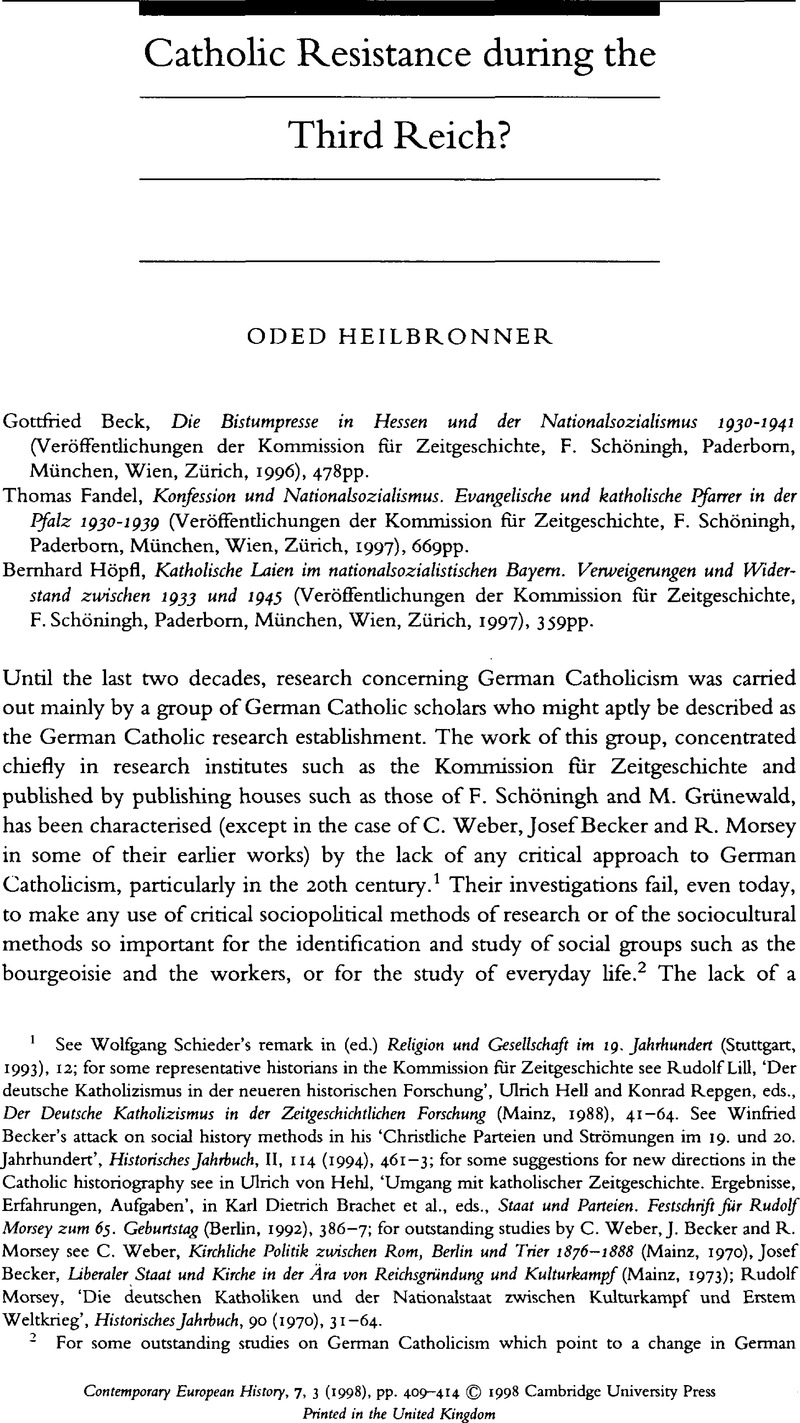No CrossRef data available.
Published online by Cambridge University Press: 12 September 2008

1 See Schieder's, Wolfgang remark in (ed.) Religion und Gesellschaft im 19. Jahrhundert (Stuttgart, 1993), 12Google Scholar; for some representative historians in the Kommission für Zeitgeschichte see Lill, Rudolf, ‘Der deutsche Katholizismus in der neueren historischen Forschung’, Hell, Ulrich and Repgen, Konrad, eds., Der Deutsche Katholizismus in der Zeitgeschichtlichen Forschung (Mainz, 1988), 41–64Google Scholar. See Becker's, Winfried attack on social history methods in his ‘Christliche Parteien und Strömungen im 19. und 20. Jahrhundert’, Historisches Jahrbuch, II, 114 (1994), 461–3Google Scholar; for some suggestions for new directions in the Catholic historiography see in von Hehl, Ulrich, ‘Umgang mit katholischer Zeitgeschichte. Ergebnisse, Erfahrungen, Aufgaben’, in Brachet, Karl Dietrich et al. , eds., Staat und Parteien. Festschrift für Rudolf Morsey zum 65. Geburtstag (Berlin, 1992), 386–7Google Scholar; for outstanding studies by Weber, C., Becker, J. and Morsey, R. see Weber, C., Kirchliche Politik zwischen Rom, Berlin und Trier 1876–1888 (Mainz, 1970)Google Scholar, Becker, Josef, Liberaler Staat und Kirche in der Ära von Reichsgründung und Kulturkampf (Mainz, 1973)Google Scholar; Morsey, Rudolf, ‘Die deutschen Katholiken und der Nationalstaat zwischen Kulturkarnpf und Erstem Weltkrieg’, Historisches Jahrbuch, 90 (1970), 31–64.Google Scholar
2 For some outstanding studies on German Catholicism which point to a change in German Catholic studies see Blackbourn, David, The Marpingen Visions. Rationalism, Religion and the Rise of Modem Germany (London, 1995)Google Scholar; Blaschke, Olaf and Kuhlemann, Frank-M., eds., Religion im Kaiserreich. Milieus-Mentalitäten-Krisen, (Gütersloh, 1996)Google Scholar; Mergel, Thomas, Zwischen Klasse und Konfession. Katholisches Bürgertum im Rheinland 1790–1914 (Göttingen, 1994)Google Scholar; Schieder, Wolfgang, ed., Religion und Gesellschaft im 19. Jahrhundert (Stuttgart, 1993)Google Scholar; Schlögl, Rudolf, Glaube und Religion in der Säkularisierung. Die katholische Stadt–Köln, Aachen, Münster 1700–1840 (Munich, 1995)Google Scholar; Smith, Helmut Walser, German Nationalism and Religious Conflict, Culture, Ideology, Politics, 1870–1914 (Princeton, 1995).Google Scholar
3 According to Blaschke, Olaf and Kuhlemann, Frank-M. ‘mesomilieus’ are large religious regions (the Catholic regions of Upper and Lower Bavaria, the Protestant districts of Upper Franconia) where a specific religious identity is reflected in local religious habits and institutions (e.g. Catholic workers' Vereine).Google Scholar See Blaschke, and Kuhlemann, , Religion im Kaiserreich, 47–8.Google Scholar
4 Even Höpfl's book which should, according to his title, cover the war years, deals mainly with the period before 1939.Google Scholar
5 On this topic see Smolinsky, H., ‘Das katholische Russlandbild in Deutschland nach dem Ersten Weltkrieg und im “Dritten Reich”’, in Volkmann, H.-E., ed., Das Russlandbild im Dritten Reich (Cologne, 1994), 323–56Google Scholar; Besier, Gerhard, ‘Anti-Bolshevism and Antisemitism: The Catholic Church in Germany and National-Socialist Ideology 1936–1937’, JEcclH, 43 (1992), 447–56Google Scholar; Kai-U. Merz ‘Die Germania: Der Anti-bolschewismus des katholischen Zentrums’, idem, Das Schreckbild. Deutschland und der Bolschewismus 1917 bis 1921 (Berlin, 1995), 225–84.
6 Some other examples: Wagener, U., ed., Das Erzbistum Paderborn in der Zeit des Nationalsozialismus. Beiträge zur regionalen Kirchengeschichte 1933–1945 (Paderbom, 1993)Google Scholar; Klein, A., Katholisches Milieu und Nationalsozialismus. Der Kreis Olpe 1933–1939 (Siegen, 1994)Google Scholar; Breuer, T., Verordneter Wandel? Der Widerstreit zwischen nationalsozialistischem Herrschaftsanspruch und traditionaler Lebenswelt im Erzbistum Bamberg (Mainz, 1992).Google Scholar
7 ‘Piety and Politics: Recent Works on German Catholicism’, Journal of Modern History, 63 (1991), 697.Google Scholar
8 Klerus und abweichendes Verhalten. Zur Sozialgeschichte katholischer Priester im 19. Jahrhundert. Die Erzdiözese Freiburg (Göttingen, 1994).Google Scholar
9 For this group see Heilbronner, Oded, ‘In Search of the Catholic (Rural) Bourgeoisie’, Central European History, Vol. 29, no. 2,(1996), 176–201CrossRefGoogle Scholar; idem, ‘Reichstagswahlkämpfe im Allgäu 1871–1932: Ein abweichender Fall?’, Zeitschrift für Bayerische Landesgeschichte, 61 (1997); for Munich see Large, David, Where Ghosts Walked: Munich's Road to the Third Reich (New York, 1997).Google Scholar
10 Heilbronner, Oded, ‘Katholische Vision des Reiches unterm Nationalsozialismus’, Tel-Aviver Jahrbuch für Deutsche Geschichte, Vol. XXV (1996), 219–32.Google Scholar
11 For new directions in this topic see Smith, Helmut W., ‘The Learned and the Popular Discourse of Anti-Semitism in the Catholic Milieu of the Kaiserreich’, Central European History, Vol. 3 (1994), 315–29Google Scholar; Langer, Michael, Zwischen Vorurteil und Aggression. Zum Judenbild in der deutschsprachigen katholischen Volksbildung des 19. Jh. (Freiburg, 1994)Google Scholar; Blaschke, Olaf, Katholizismus und Antisemitismus im Deutschen Kaiserreich (Göttingen, 1997).Google Scholar
12 I made a study of the south-German Catholics in my Catholicism, Political Culture and the Countryside. A Social History of the Nazi Party in South Germany (Ann Arbor, 1998).Google Scholar
13 Hamerow, T., On the Road to the Wolf's Lair: German Resistance to Hider (Cambridge, MA, 1997), ch. 8.Google Scholar
14 Lewy, G., The Catholic Church and Nazi Germany (New York, 1964), ch. 8.Google Scholar